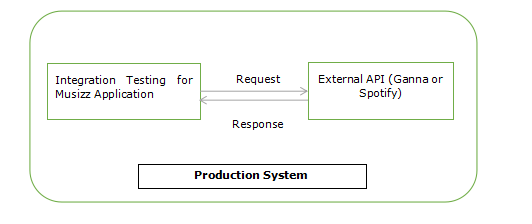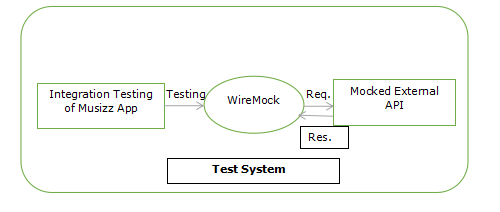
 Data Structure
Data Structure Networking
Networking RDBMS
RDBMS Operating System
Operating System Java
Java MS Excel
MS Excel iOS
iOS HTML
HTML CSS
CSS Android
Android Python
Python C Programming
C Programming C++
C++ C#
C# MongoDB
MongoDB MySQL
MySQL Javascript
Javascript PHP
PHP
- Selected Reading
- UPSC IAS Exams Notes
- Developer's Best Practices
- Questions and Answers
- Effective Resume Writing
- HR Interview Questions
- Computer Glossary
- Who is Who
Wiremock VS Mockito
Mockito is built for testing the unit, whereas Wiremock is built specifically for the integration testing. Mockito aids itself as "a mocking framework that tastes really great" whereas wiremock stimulates itself as "a simulator for HTTP-based APIs".
Both wiremock and mockito are the technologies used for testing that is widely used for unit and integration testing in natural world applications. Developers have to understand these two important terms and how they differ from each other to use them in an effective way.
Therefore, we will cover the main difference between these two extensively used tools in this article.
What is Wiremock?
A tool for emulating HTTP-based APIs that might be used in unit tests, on a desktop, or in a test environment called wiremock. It can also be alluded to as a forged server, a service virtualization tool, or a simulator for HTTP-based APIs. It allows you to continue your work if an API you rely on is ?
Malfunctioned
Expensive
Not available
Not complete
It facilitates the testing of edge cases and failure modes. It moves rapidly, significantly reducing build time. In simple words, Wiremock is a mocking platform for integration testing. It is primarily used when a system interacts with one or more internal/external components or amenities, and more significantly when integration testing is being implemented.
Example
For example, we are building an application named Musizz and we have a feature in the app in which we have to connect with an external API provided by other music apps such as Ganna, Spotify etc. But the question that comes here is How to perform the integration testing with the external APIs. So there will be two approaches to this.
Approaches
Approach1
This approach is so evident. That means we can test it with several testing environments or with the actual production environment. But this approach comes with several challenges ?
Sometimes it cost expensive to hit the API
The external API system may not be available always which means we are completely dependent on any downtime in the system
Sometimes, it does not consist test environment

Figure-1
Approach 2
The second approach is to use a web server which mocks responses to the request received for the dependencies.

Figure-2
What is Mockito?
In the same way, Mockito is a framework used for testing open-source units in Java applications. It is essential for making apps that can be tested. Software testing that concentrates on evaluating particular software units is known as unit testing. The main purpose of using this framework is to make test development easy by using mocks of external dependencies in the test code. And as an outcome, mockito offers test code that is more optimized, accessible and adaptable in nature. It can also collaborate with other frameworks like JUnit and TestNG.
Approach
Mockito mock provides many different approaches to mocking a class. Some of them are mentioned below ?
Approach 1
Mock objects of a specific class or interface can be made using it. There are five mock() methods in Mockito, each with a unique parameter. Mocks will return a default value if we didn't assign them anything. The same task of mimicking the objects is carried out by all five techniques.
All five mock() methods are mentioned below
mock() with Class
It is used to develop mock objects of a concrete interface. It takes an interface name as a parameter.
Syntax
<T> mock(Class<T> classToMock)
mock() with Answer
It is used to develop mock objects of an interface with a particular procedure. It is an advanced mock method, which might be used when working with legacy systems. It takes the Answer as a parameter along with the interface name. The Answer is an enumeration of per-configured mock answers.
Syntax
<T> mock(Class<T> classToMock,Answer defaultAnswer)
mock() with MockSettings
It is used to develop mock objects with some non-standard settings. It takes MockSettings as an additional setting parameter along with the interface name. It enables the creation of mock objects with additional settings.
Syntax
<T> mock(Class<T> classToMock,MockSettings mockSettings)
mock() with ReturnValues
It enables the creation of mock objects of an assigned interface. Now, It is deprecated as ReturnValues are replaced with Answer.
Syntax
<T> mock(Class<T> classToMock,ReturnValues returnValues)
mock() with String
It is used to develop mock objects by specifying the mock names. In debugging, naming mock objects might be helpful whereas, it is a bad option for use in a huge and complex code.
Syntax
<T> mock(Class<T> classToMock,String name)
The following code presents how to use mock() method ?
ToDoService doService = mock(ToDoService.class);
Approach 2
The spy method, which Mockito offers, is a way to spoof an object just partially. When employing the spy approach, spies or stubs are made out of genuine objects that already exist. Without utilizing spy to stub out a method, the true method behaviour will be called. The spy() method's primary purpose is to override the real object's unique methods. Verifying the call of a certain method is one of the tasks performed by the spy() method.
The Mockito has two varieties of spy() method ?
spy() method
It develops a spy of a real object. It calls the real methods unless they are stubbed. We should use real spies carefully and rarely. For example, when dealing with legacy code.
Syntax?
<T> spy(T object)
spy() method with Class
It develops a spy object on a class instead of an object. The spy(T object) method is particularly useful for spying on abstract classes because they cannot be instantiated.
Syntax
<T> spy(Class<T> classToSpy)
The following code present how to use spy() method ?
ListspyArrayList = spy(ArrayList.class);
Why we should use Wiremock instead of Mockito?
For HTTP-based APIs, Wiremock gives a simulator, while Mockito offers a mock model of the characteristic or item.If we're aiming toreturn the object or response without testing any code to call a relaxation provider, achieve an HTTP response, and deserialize the identical, then we use Mockito to simulate the HTTP-based total technique. the use of Wiremock will permit us to behaviour checking out this is as realistic as possible as it simulates both the rest name's invocation and the response's deserialization.
Difference between WireMock and Mockito
WIREMOCK |
MOCKITO |
|---|---|
Web server act like real API |
No web server |
Real HTTP call |
No HTTP call available |
External to the app code |
Part of application code |
Can simulate the network calls |
Can't simulate the network calls |
It is not language-specific. This implies that if you are working on a Rest based response, you can simple use Wiremock regardless of whether you are using Java, Python, or Groovy. |
However, Mockito is a mocking library that is specialized to a certain language. For instance, the mocking library is known as Mockito in Java programming, whereas it goes by a different name in other programming language. |
Conclusion
Wiremock and mockito both vary from each other in many ways. Wiremock can simulate network calls whereas mockito cannot simulate network calls. Mockito is also a mocking library that is specialized to a certain language but wiremock is not specific when it comes to language.

